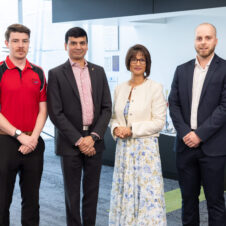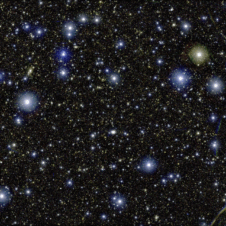Galaxies are being killed in one of the most extreme regions of the nearby Universe and astronomers think they know why. A paper published today in the Astrophysical Journal Supplement Series provides the clearest evidence yet that the extreme environments surrounding galaxies can reach far within them and steal their molecular gas – the fuel needed to birth new stars and keep a galaxy alive.
This paper by a collaboration of 36 international astronomers, including researchers from the University of Western Australia node of the International Centre for Radio Astronomy Research (ICRAR), presents state-of-the-art observations of molecular gas in 51 galaxies belonging to the Virgo Cluster. It’s the first paper to be released from the Virgo Environment Traced in Carbon Monoxide Survey (VERTICO), undertaken using the Atacama Large Millimeter/submillimeter Array (ALMA) in Chile.
“We know that galaxies in the most extreme environments suffer tremendously, losing their gas reservoirs and eventually being unable to form any more stars. For a galaxy that’s the equivalent of dying” said co-author Dr Claudia Lagos, ASTRO 3D Senior Research Fellow at ICRAR-UWA. “VERTICO offers us an unprecedented window on how the molecular gas, the direct fuel for new stars, is affected, allowing us to effectively diagnose what’s killing those galaxies.”
A galaxy’s ability to form stars is influenced by where the galaxy lives in the Universe and how it interacts with its surroundings. Of the many different environments in the Universe, galaxy clusters are among the most massive, hottest, and most extreme, making them the perfect cosmic laboratory for observations such as VERTICO. The nearby Virgo Cluster is seven million light-years across and contains thousands of galaxies hurtling through superheated plasma at speeds of up to several million kilometres per hour. It is an environment so extreme and inhospitable that entire galaxies can be stopped from forming stars in a process known as galaxy quenching. Not to worry though, our own Milky Way galaxy is nowhere near any cluster and isn’t in any danger of having its gas stripped away.
“With VERTICO, we looked at the gas reservoir of 51 galaxies in the Virgo Cluster, one of the most extreme environments we know of. We were able to create among the most detailed maps of the distribution of gas in cluster galaxies ever observed. These images provide the missing pieces of the puzzle of how environment affects the gas content of galaxies, specially the dense and cold gas, and hence their ability to form stars.” explains Lagos.

The VERTICO—Virgo Environment Traced in Carbon Monoxide—Survey observed the gas reservoirs in 51 galaxies in the nearby Virgo Cluster and found that the extreme environment in the cluster was killing galaxies by robbing them of their star-forming fuel. In this composite image, ALMA’s radio wavelength observations of the VERTICO galaxies’ molecular gas disks are magnified by a factor of 20. They are overlaid on the X-ray image of the hot plasma within the Virgo Cluster.
Credit: ALMA (ESO/NAOJ/NRAO)/S. Dagnello (NRAO)/Böhringer et al. (ROSAT All-Sky Survey)
In the new results, the majority of VERTICO galaxies show evidence that the cluster environment left an imprint on their gas disks, providing the clearest evidence yet that external environmental mechanisms reach far into galaxies to disturb and perturb their molecular gas, and impact their star formation.

NGC 4567 and NGC 4568 are 2 of the 2,000 galaxies in the Virgo Cluster, located roughly 65 million light-years from Earth. Observed by the VERTICO—Virgo Environment Traced in Carbon Monoxide—Survey, the 2 galaxies are among those in the galaxy cluster impacted by extreme physical processes that can lead to the death of galaxies. The galaxies are shown here in composite radio data from ALMA with molecular gas in red/orange and optical data from the Hubble Space Telescope with stars in white/blue. Credit: ALMA (ESO/NAOJ/NRAO)/S. Dagnello (NRAO)
“Gas stripping is one of the most spectacular and violent external mechanisms that can shut down star formation in galaxies.” explains lead author Dr Toby Brown, ICRAR alumnus and Plaskett Fellow at the National Research Council of Canada. “Gas stripping occurs when galaxies are moving so fast through hot plasma in the cluster, that vast quantities of cold molecular gas are stripped from the galaxy – as though the gas is being swept away by a huge cosmic broom. The exquisite quality of VERTICO’s observations allows us to better see and understand such mechanisms.”
This unprecedented detail of galaxies in the highly active Virgo Cluster will provide astronomers with the data needed to study and better understand how star formation and galaxy evolution proceed in the most extreme environments in the Universe, in an effort to better understand our own.
MORE INFO:
VERTICO
The Virgo Environment Traced in Carbon Monoxide Survey (VERTICO) is the first ever Canadian-led ALMA Large Program, a specific subset of ALMA observations designed to address strategic scientific issues that will lead to a major advance or breakthrough. While Virgo has been studied at almost every wavelength of cosmic light, this is the first large survey of molecular gas with high sensitivity and resolution in a galaxy cluster.
ICRAR
The International Centre for Radio Astronomy Research (ICRAR) is a joint venture between Curtin University and The University of Western Australia with support and funding from the State Government of Western Australia.
PUBLICATION:
‘VERTICO: The Virgo Environment Traced In CO Survey’, published in Astrophysical Journal Supplement Series on November 2, 2021.
CONTACTS:
Dr Claudia Lagos (ICRAR/UWA)
Ph: +61 405 574 106 E: claudia.lagos@icrar.org
Cass Rowles (Media Contact, ICRAR)
Ph: +61 420 976 086 E: cass.rowles@icrar.org
Simone Hewett (Media Contact, University of Western Australia)
Ph: +61 8 6488 3229 E: simone.hewett@uwa.edu.au

